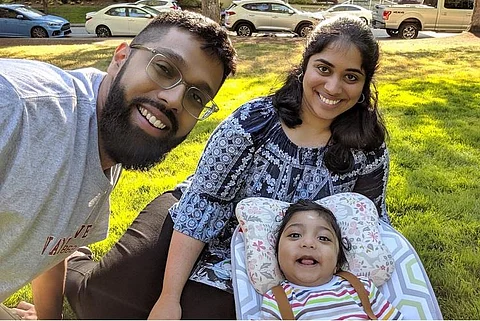

‘Four hours after the baby was born, doctors came up to me and said “Your son is different”,’ writes Seattle-based Sanath Kumar Ramesh in his post on the platform Medium.
Sanath and his wife Ramya originally hail from Chennai and have been living in Seattle for almost a decade now. Their son, Raghav, who is just a little over a year old now, was born with an extremely rare mutation in a gene called GPX4.
The boy spent the first 23 days of his life in the hospital as doctors examined and tested him, until a diagnosis came, on the day he turned one year old.
It was at Raghav’s birthday party that his parents received a phone call from the Genetics Department at the Seattle Children’s hospital, informing them of his rare diagnosis.
How rare?
“So rare, only two other babies in the world were known to have it. So dangerous, both the babies passed away within 30 days after birth. Your son is doing much better,” the official from Genetics Department at the Seattle Children’s hospital had stated, according to Sanath.
Sanath and his wife Ramya were unsure how to receive the news. “‘Your son is doing much better’ almost sounded to me like ‘Is your son still alive!? [...]” Sanath wrote.
Raghav’s genetic condition has resulted in anatomical and structural defects, which, in medical terms, is called sedaghatian type spondylometaphyseal dysplasia (SMDS).
“Raghav is one year old but cannot sit up without support. He doesn’t have the muscle strength to hold a toy in his hand. He doesn’t have the oral strength to swallow food. He cannot hear normally. His bones are not developing as expected. We really don’t know what his future looks like,” Sanath says, describing the delays in his son’s development as a result of the condition.
However, despite being aware of the odds, the couple didn’t give up hope. They searched for a way to help their son, which began with first understanding his condition.
“We learned that this particular condition is more likely to occur in South Asians. It is a condition which is inherited as an autosomal recessive,” says Ramya to TNM over the phone.
An individual can inherit two types of genes – autosomal dominant or autosomal recessive. When two copies of an abnormal gene (one from each parent) are inherited and result in a genetic mutation, this is referred to as an autosomal recessive condition, which is what happened in Raghav’s case.
“It’s just random luck. The probability of finding individuals with at least one copy of the abnormal gene is high in the South Asian population. Both Sanath and I are carriers of the gene in this case,” Ramya adds.
There is no treatment currently available. Doctors say that Raghav will have to be treated symptomatically.
After months of despair, the couple finally came in touch with Dr Russell Saneto, a professor of Neurology at the University of Washington who is an expert on Mitochondrial diseases. Mitochondria is the “powerhouse” of every cell in the body, and it aids in producing the energy required for a cell to function. Mitochondrial diseases affect the cell’s ability to adequately produce or utilise the energy.
The professor agreed to research Raghav’s condition to better understand it. He plans on recreating the disease in a mouse so that the disease can be better comprehended and treatment options can be brainstormed.
A fundraiser has been setup to aid in the cost incurred by the research which may potentially save the life of little Raghav, and perhaps others like him. Within 24 hours, the couple has been able to raise 75,000 US dollars via crowdfunding, but the costs are expected to soar higher.
You can help by donating to their cause using the links below.